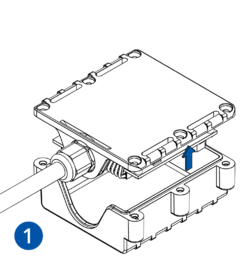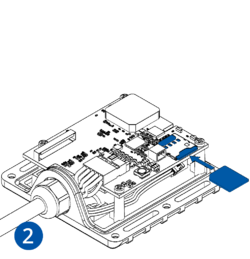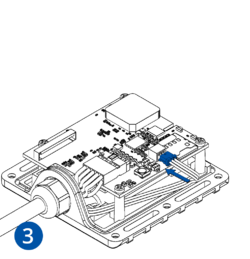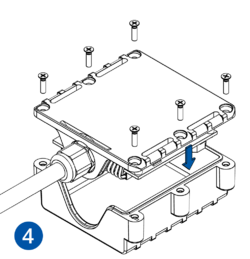TFT100 First Start
Small, professional and waterproof tracker for forklifts, E-mopeds and E-scooters with internal high gain GNSS/GSM antennas, Bluetooth® wireless technology, high capacity internal Li-ion battery and 10-97 V power supply range.
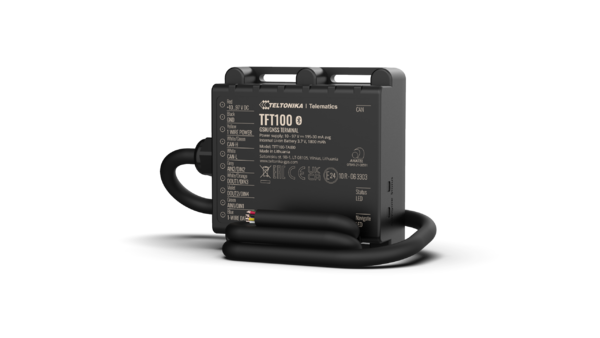
Pinout
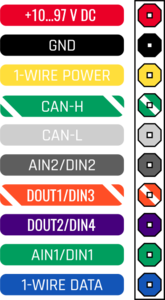 |
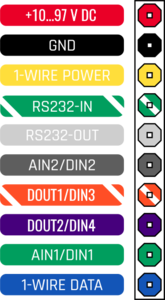 |
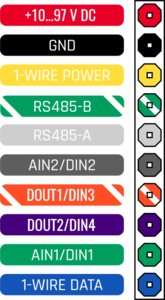 |
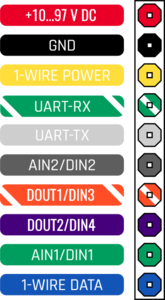 |
| PIN COLOR | CAN PIN NAME |
CAN DESCRIPTION |
RS232 PIN NAME |
RS232 DESCRIPTION |
RS485 PIN NAME |
RS485 DESCRIPTION |
UART PIN NAME |
UART DESCRIPTION |
|
|---|---|---|---|---|---|---|---|---|---|
| Red | VCC (10-97)V DC (+) | Power supply (+10...97 V DC). | VCC (10-97)V DC (+) | Power supply (+10...97 V DC). | VCC (10-97)V DC (+) | Power supply (+10...97 V DC). | VCC (10-97)V DC (+) | Power supply (+10...97 V DC). | |
| Black | GND (-) | Ground. | GND (-) | Ground. | GND (-) | Ground. | GND (-) | Ground. | |
| Yellow | 1WIRE POWER | Power supply pin for Dallas 1-Wire devices | 1WIRE POWER | Power supply pin for Dallas 1-Wire devices | 1WIRE POWER | Power supply pin for Dallas 1-Wire devices | 1WIRE POWER | Power supply pin for Dallas 1-Wire devices | |
| White/Green | CAN-H | CAN interface High. | RS232-IN | Input wire for RS232. | RS485-B | Signal wire B for RS485. | UART-RX | Input for data reception through UART. | |
| White | CAN-L | CAN interface Low. | RS232-OUT | Output wire for RS232. | RS485-A | Signal wire A for RS485. | UART-TX | Output for data transmission through UART. | |
| Grey | AIN 2 / DIN 2 |
Analog input, channel 2 / Digital input, channel 2. | AIN 2 / DIN 2 |
Analog input, channel 2 / Digital input, channel 2. | AIN 2 / DIN 2 |
Analog input, channel 2 / Digital input, channel 2. | AIN 2 / DIN 2 |
Analog input, channel 2 / Digital input, channel 2. | |
| White/Orange | DOUT 1 / DIN 3 |
Digital output, channel 1 / Digital input, channel 3. | DOUT 1 / DIN 3 |
Digital output, channel 1 / Digital input, channel 3. | DOUT 1 / DIN 3 |
Digital output, channel 1 / Digital input, channel 3. | DOUT 1 / DIN 3 |
Digital output, channel 1 / Digital input, channel 3. | |
| Violet | DOUT 2 / DIN 4 |
Digital output, channel 2 / Digital input, channel 4. | DOUT 2 / DIN 4 |
Digital output, channel 2 / Digital input, channel 4. | DOUT 2 / DIN 4 |
Digital output, channel 2 / Digital input, channel 4. | DOUT 2 / DIN 4 |
Digital output, channel 2 / Digital input, channel 4. | |
| Green | AIN 1 / DIN 1 |
Analog input, channel 1 / Digital input, channel 1. | AIN 1 / DIN 1 |
Analog input, channel 1 / Digital input, channel 1. | AIN 1 / DIN 1 |
Analog input, channel 1 / Digital input, channel 1. | AIN 1 / DIN 1 |
Analog input, channel 1 / Digital input, channel 1. | |
| Blue | 1WIRE DATA | Data channel for 1–Wire devices. | 1WIRE DATA | Data channel for 1–Wire devices. | 1WIRE DATA | Data channel for 1–Wire devices. | 1WIRE DATA | Data channel for 1–Wire devices. |
Set up your device
How to insert Micro-SIM card
- Remove the bottom cover.
- Insert Micro-SIM card as shown with PIN request disabled or read Security info how to enter it later in Configurator. Make sure that Micro-SIM card cut-off corner is pointing forward to slot.
- Connect the battery as shown to the device.
- After configuration, attach device cover and put the screws back in.
- Device is ready to be connected.
 |
Micro-SIM card insertion/removal must be performed when device is powered off – external voltage and battery are disconnected. Otherwise Micro-SIM card might be damaged or device will not detect it. |
PC Connection (Windows)
- Power-up TFT100 with DC voltage 10 - 97V power supply using supplied power cable. LED’s should start blinking, see “LED behaviour description”.
- Connect device to computer using Micro-USB cable or Bluetooth® connection:
- Using Micro-USB cable
- You will need to install USB drivers, see "How to install USB drivers (Windows)"
- Using Bluetooth®
- TFT100 Bluetooth® is enabled by default. Turn on Bluetooth® on your PC, then select Add Bluetooth® or other device > Bluetooth®. Choose your device named – “TFT100_last_7_imei_digits”, without LE in the end. Enter default password 5555, press Connect and then select Done.
- Using Micro-USB cable
- You are now ready to use the device on your computer.
How to install USB drivers (Windows)
- Please download COM port drivers from here.
- Extract and run TeltonikaCOMDriver.exe.
- Click Next in driver installation window.
- In the following window click Install button.
- Setup will continue installing the driver and eventually the confirmation window will appear. Click Finish to complete the setup.
Configuration (Windows)
At first TFT100 device will have default factory settings set. These settings should be changed according to the user's needs.
Main configuration can be performed via Teltonika Configurator software. Get the latest TFT100 Configurator version from here. Configurator operates on Microsoft Windows OS and uses prerequisite MS .NET Framework. Make sure you have the correct version installed.
| MS .NET requirements | |||
|---|---|---|---|
| Operating system | MS .NET Framework version | Version | Link |
|
MS .NET Framework 4.6.2 | 64 bit | .NET Framework |
Downloaded Configurator will be in compressed archive. Extract it and launch Configurator.exe. After launch software language can be changed by clicking ![]() in the right bottom corner:
in the right bottom corner:
Configuration process begins by pressing on connected device:
After connection to Configurator Status window will be displayed:
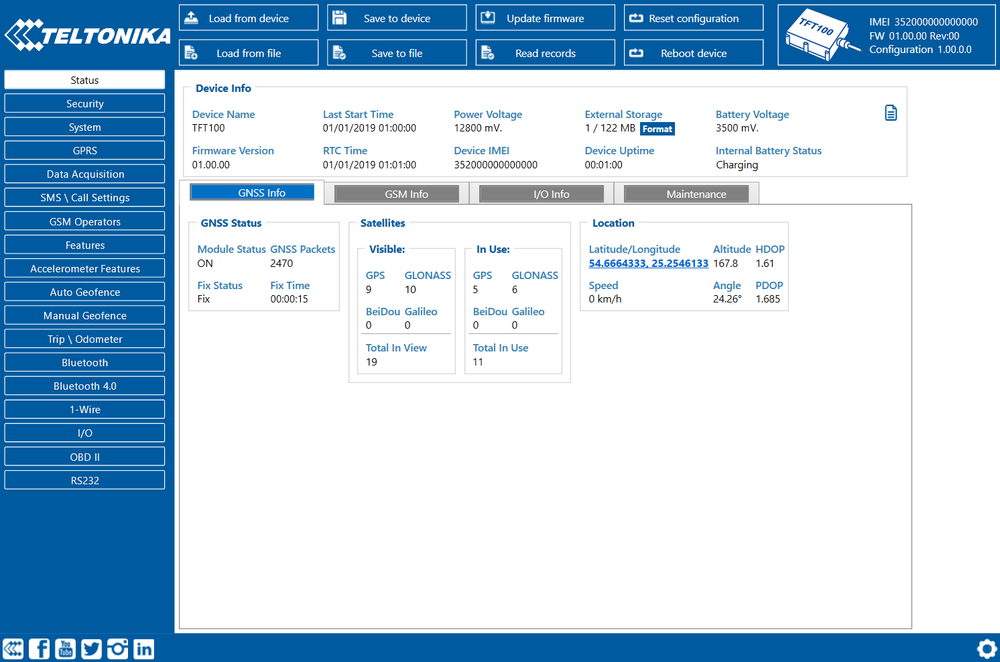
Various Status window tabs display information about GNSS, GSM, I/O, Maintenance and etc. TFT100 has one user editable profile, which can be loaded and saved to the device. After any modification of configuration the changes need to be saved to device using Save to device button. Main buttons offer following functionality:
 Load from device – loads configuration from device.
Load from device – loads configuration from device. Save to device – saves configuration to device.
Save to device – saves configuration to device. Load from file – loads configuration from file.
Load from file – loads configuration from file. Save to file – saves configuration to file.
Save to file – saves configuration to file. Update firmware – updates firmware on device.
Update firmware – updates firmware on device. Read records – read records from device.
Read records – read records from device. Reboot device – restarts device.
Reboot device – restarts device. Reset configuration – sets device configuration to default.
Reset configuration – sets device configuration to default.
Most important configurator section is GPRS – where all your server and GPRS settings can be configured and Data Acquisition – where data acquiring parameters can be configured. More details about TFT100 configuration using Configurator can be found in the manual.
Quick SMS configuration
Default configuration has optimal parameters present to ensure best performance of track quality and data usage.
Quickly set up your device by sending this SMS command to it:
" setparam 2001:APN;2002:APN_username;2003:APN_password;2004:Domain;2005:Port;2006:0"
GPRS settings:
- 2001 – APN
- 2002 – APN username (if there are no APN username, empty field should be left)
- 2003 – APN password (if there are no APN password, empty field should be left)
Server settings:
- 2004 – Domain
- 2005 – Port
- 2006 – Data sending protocol (0 – TCP, 1 – UDP)
Note: Before SMS text, two space symbols should be inserted.
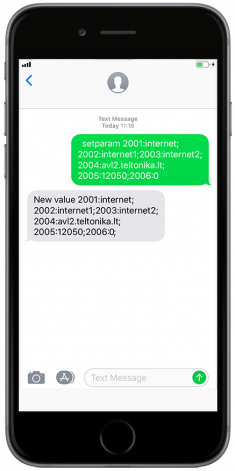
After successful SMS configuration, TFT100 device will synchronize time and update records to configured server. Time intervals and default I/O elements can be changed by using Teltonika Configurator or SMS parameters.
Mounting recommendations
- Connecting wires
- Wires should be connected while the module is not plugged in.
- Wires should be fastened to stable wires or other non-moving parts. Any heat emitting and/or moving objects should be kept away from the wires.
- There should be no exposed wires. If factory isolation was removed while connecting wires, the isolation material should be applied.
- If the wires are placed in the exterior or in places where they can be damaged or exposed to heat, humidity, dirt, etc., additional isolation should be applied and the wires should not be loose.
- Connecting ignition wire
- Be sure to check if it is a real ignition wire i. e. power does not disappear after starting the engine.
- Check if this is not an ACC wire (when key is in the first position, most of the vehicle electronics are available).
- Check if power is still available when you turn off any of vehicles devices.
- Ignition is connected to the ignition relay output. As alternative, any other relay, which has power output when ignition is on, may be chosen.
- Connecting ground wire
- Ground wire is connected to the vehicle frame or metal parts that are fixed to the frame.
- If the wire is fixed with the bolt, the loop must be connected to the end of the wire.
- For better contact scrub paint from the spot where loop is going to be connected.
 |
PAY ATTENTION! Connecting the power supply must be carried out in a very low impedance point of on-board vehicle network. These points in the car are the battery terminals. Therefore, we recommend connecting the power of TFT100 (GND and POWER wires) directly to the battery terminals. Another valid option is to connect the wires to the main POWER cable inside the fuse box (if there is none, then to the power supply where the fuses of vehicle’s computer are), GND wire must be connected in a special point, designed to connect GND vehicle computer. Connecting the GND at an arbitrary point to the mass of the car is unacceptable, as static and dynamic potentials on the line GND will be unpredictable, which can lead to unstable TFT100 operation and even its failure. |

